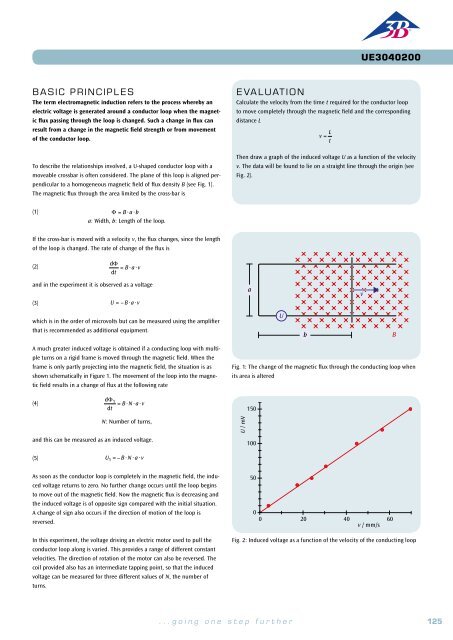3B Scientific - Physics & Engineering Experiments
3B Scientific - Physics & Engineering Experiments
3B Scientific - Physics & Engineering Experiments
You also want an ePaper? Increase the reach of your titles
YUMPU automatically turns print PDFs into web optimized ePapers that Google loves.
UE3040400<br />
Electricity / Electromagnetic induction<br />
Waltenhofen’s Pendulum<br />
UE3040400<br />
OBJECTIVE<br />
Demonstrate and investigate how an eddy-current brake works<br />
I<br />
B 2<br />
F 2<br />
B 1<br />
SUMMARY<br />
In a metal disc moving through a uniform magnetic field, eddy currents get<br />
induced. The uniform magnetic field exerts a force due to these currents<br />
that causes the disc to slow down.<br />
F 1<br />
BASIC PRINCIPLES<br />
When a metal disc moves through a uniform magnetic field each section<br />
of the disc experiences constantly changing magnetic flux and an eddy<br />
voltage is induced therein. This causes electrical eddy currents to flow<br />
all over the disc. These are subject to Lorentz forces within the magnetic<br />
field that act to slow down the motion of the disc. These eddy currents<br />
are drastically reduced if the metal disc has slots in it. This means<br />
that the current has to flow from one segment to the next by a more circuitous<br />
route. Such a disc is slowed down only slightly.<br />
The emergence and suppression of eddy currents can be clearly demonstrated<br />
using a Waltenhofen pendulum. This includes a partially slotted metal<br />
disc that oscillates inside a uniform magnetic field.<br />
Eddy current I in a metal disc moving at speed v through a uniform<br />
magnetic field B 1<br />
, B 2<br />
with Lorentz forces F 1<br />
and F 2<br />
acting on both limbs of<br />
the eddy. The force acting against the motion is greater than that operating<br />
in the same direction.<br />
EVALUATION<br />
When a metal disc without slots moves through the uniform magnetic<br />
field, its oscillation is damped. The damping increases with the magnitude<br />
of the magnetic field. Eddy currents are induced within the disc<br />
and the magnetic field itself exerts a force as a result that opposes the<br />
motion (cf. Lenz’s law).<br />
V<br />
If the slotted disc moves through the field, the damping of the motion<br />
is only slight since it is much more difficult for the eddy currents to<br />
form.<br />
EXPERIMENT<br />
PROCEDURE<br />
• Investigate the braking of a Waltenhofen<br />
pendulum due to eddy currents<br />
in a uniform magnetic field.<br />
• Demonstrate the suppression of eddy<br />
currents in a disc with slots.<br />
1<br />
required apparatus<br />
Quantity Description Number<br />
1 Waltenhofen’s Pendulum 1000993<br />
1 Tripod Stand 150 mm 1002835<br />
1 Stainless Steel Rod 750 mm 1002935<br />
1 Universal Clamp 1002830<br />
1 DC Power Supply 0 – 20 V, 0 – 5 A (230 V, 50/60 Hz) 1003312 or<br />
DC Power Supply 0 – 20 V, 0 – 5 A (115 V, 50/60 Hz) 1003311<br />
1 U Core 1000979<br />
1 Pair of Pole Shoes 1000978<br />
1 Pair of Clamps 1000977<br />
2 Coil D with 1200 Taps 1000989<br />
1 Set of 15 Safety Experiment Leads, 75 cm 1002843<br />
126 <strong>3B</strong> <strong>Scientific</strong>® <strong>Experiments</strong><br />
...going one step further<br />
127















